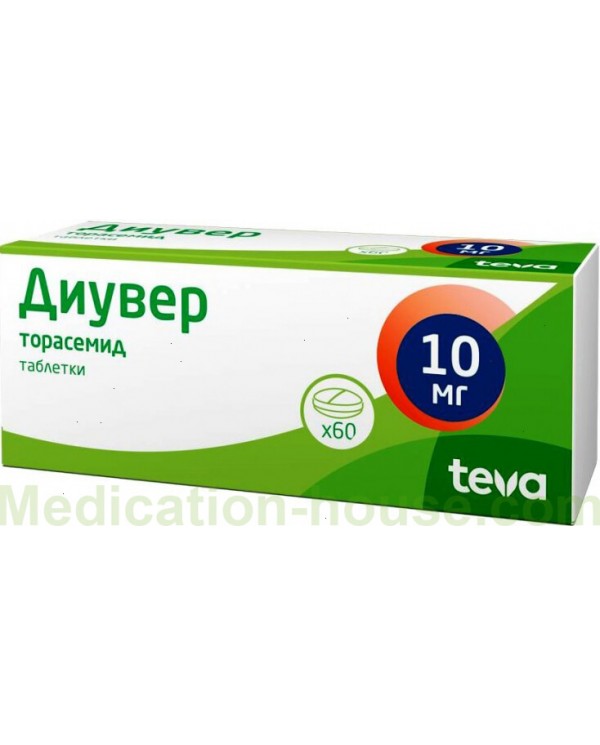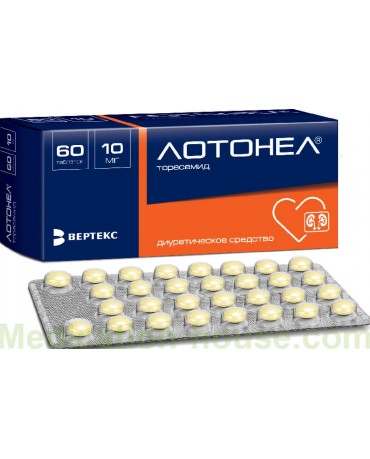Instruction for Diuver
Reed more and buy Diuver on this page
Diuver is a loop diuretic.
Release form and composition
Available in tablets: round, biconvex, white or almost white, with a chamfer, on one side - engraving "915" (5 mg) or "916" (10 mg), on the other - risk (10 pcs. In blisters, in a cardboard box 2 or 6 blisters and instructions for the use of Diuver).
Active ingredient: torasemide, in 1 tablet - 5 or 10 mg.
Additional components: lactose monohydrate, corn starch, sodium carboxymethyl starch, colloidal anhydrous silicon dioxide, magnesium stearate.
Pharmacodynamics
Torasemide - Diuver's active substance, is a loop diuretic. Its main mechanism of action is based on reversible binding to the Na + / 2Cl– / K + cotransporter, which is located in the apical membrane of the thick segment of the ascending part of Henle's loop. Due to this, there is a decrease or complete inhibition of the reabsorption of sodium ions, a decrease in the osmotic pressure of the intracellular fluid and reabsorption of water. There is also a blockage of aldosterone receptors in the myocardium, a decrease in fibrosis and an improvement in diastolic myocardial function.
Hypokalemia of torasemide in comparison with furosemide causes to a lesser extent, with a greater activity of torasemide and a lengthening of the period of its action.
The greatest diuretic effect develops 2-3 hours after oral administration of Diuver.
A long course is possible.
Pharmacokinetics
Torasemide after oral administration is rapidly and almost completely absorbed from the gastrointestinal tract. Cmax (maximum concentration of the substance) in plasma is reached after 1–2 hours from the moment of taking Diuver after a meal. The bioavailability level is in the range from 80 to 90%, slight individual variation is possible.
The duration of the diuretic effect is up to 18 hours, this facilitates the tolerance of treatment due to the absence of too frequent urination in the first hours after taking torasemide inside, which limits the activity of patients.
Binds to plasma proteins at a level of more than 99%. The apparent Vd (volume of distribution) is 16 liters.
Metabolism occurs in the liver, isozymes of the cytochrome P450 system take part in it. Three metabolites (M1, M3 and M5) are formed after successive oxidation, hydroxylation, or ring hydroxylation reactions. The level of their binding to plasma proteins is 86%, 95% and 97%, respectively. T1 / 2 (half-life) of the substance and its metabolites - from 3 to 4 hours, with chronic renal failure, the value of this indicator does not change. The total clearance is 40 ml / min, the renal clearance is 10 ml / min.
The kidneys, on average, excrete about 83% of the dose taken: 24% - unchanged, 12%, 3% and 41% - as metabolites M1, M3 and M5, respectively.
T1 / 2 of torasemide in renal failure does not change, T1 / 2 of metabolites M3 and M5 - increases. With the help of hemofiltration and hemodialysis, torasemide and its metabolites are excreted slightly.
In patients with hepatic insufficiency, the plasma concentration of torasemide in the blood increases due to a decrease in the metabolism of the substance in the liver. In heart or hepatic insufficiency, T1 / 2 of torasemide and the M5 metabolite increases slightly, cumulation of the substance is unlikely.
Indications for use
Edema syndrome of various origins, including those caused by chronic heart failure, diseases of the lungs, liver and kidneys;
Arterial hypertension.
Contraindications
Absolute:
Lactose intolerance, lactase deficiency, glucose-galactose malabsorption;
Hepatic precoma and coma;
Renal failure with anuria;
Pronounced violations of the outflow of urine of any genesis (including unilateral lesion of the urinary tract);
Dehydration and hypovolemia (including with arterial hypotension);
Acute glomerulonephritis;
Severe hyponatremia or hypokalemia;
Hyperuricemia;
Hypertrophic obstructive cardiomyopathy;
Decompensated aortic and mitral stenosis;
Increased central venous pressure (more than 10 mm Hg);
Glycosidic intoxication;
Age under 18;
Lactation;
Hypersensitivity to Diuver's components or sulfonamides (sulfonylureas or sulfonamide antimicrobial agents).
Relative (diseases / conditions in which Diuver tablets should be used with caution due to the risk of complications):
Arterial hypotension;
Stenosing atherosclerosis of the cerebral arteries;
Hypoproteinemia;
Predisposition to hyperuricemia;
Violation of urine flow (for example, due to benign prostatic hyperplasia, narrowing of the urethra, or hydronephrosis);
History of ventricular arrhythmia;
Acute myocardial infarction;
Pancreatitis
Diarrhea;
Hepatorenal syndrome;
Diabetes;
Anemia;
Gout;
Pregnancy.
Diuver, instructions for use: method and dosage
Diuver tablets should be taken orally once a day (after breakfast) with plenty of water.
Recommended single (and daily at the same time) doses:
Edematous syndrome: the initial dose is 5 mg, if the effect is insufficient, the dose is increased to 20-40 mg, in some cases - up to 200 mg. It is necessary to take Diuver until the edema disappears, long-term therapy is possible;
Arterial hypertension: the initial dose is 2.5 mg (1/2 tablet), if necessary, the dose is increased to 5 mg.
Side effects
Water-electrolyte and acid-base balance: hypocalcemia, hypokalemia, hypochloremia, hypomagnesemia, hyponatremia, metabolic alkalosis (the following symptoms may indicate the development of these disorders: headache, muscle weakness, tetany, convulsions, confusion, dyspeptic disorders, heart rhythm disturbances ), dehydration and hypovolemia (more often in elderly patients; can lead to hemoconcentration with a tendency to develop thrombosis);
Cardiovascular system: arrhythmias, tachycardia, excessive decrease in blood pressure, decreased circulating blood volume, orthostatic hypotension, collapse;
Metabolism: a transient increase in the concentration of creatinine and urea in the blood, hypertriglyceridemia, hypercholesterolemia, a decrease in glucose tolerance (in some cases, the manifestation of latent diabetes mellitus is possible), an increase in the concentration of uric acid in the blood, which can increase or cause gout;
Urinary system: acute urinary retention and oliguria (especially with narrowing of the urethra, prostatic hyperplasia, hydronephrosis), hematuria, interstitial nephritis, decreased potency;
Digestive system: diarrhea, increased activity of liver enzymes, nausea, vomiting, intrahepatic cholestasis, acute pancreatitis;
Central nervous system and hearing organ: hearing impairment (usually reversible) and / or tinnitus (especially with concomitant hypoproteinemia or renal failure);
Peripheral blood: agranulocytosis, leukopenia, aplastic or hemolytic anemia, thrombocytopenia;
Skin: urticaria, bullous skin lesions or other types of rash, exfoliative dermatitis, pruritus, photosensitivity, vasculitis, purpura, fever, eosinophilia, erythema multiforme, anaphylactoid or anaphylactic reactions up to shock.
Overdose
The main symptoms: excessively increased diuresis, which is accompanied by a violation of the electrolyte balance of the blood and a decrease in the volume of circulating blood, followed by the development of a pronounced decrease in blood pressure, drowsiness, confusion, collapse; gastrointestinal upset may occur.
Therapy: it is necessary to induce vomiting, gastric lavage and the intake of activated charcoal are also indicated. In the future, symptomatic treatment is prescribed, dose reduction / cancellation of Diuver and simultaneous replenishment of circulating blood volume and indicators of acid-base and water-electrolyte balance under the control of serum electrolyte concentrations, hematocrit.
There is no specific antidote. Hemodialysis is ineffective.
Special instructions
Diuver must be taken strictly as directed by a doctor.
Diuver's diuretic effect lasts up to 18 hours, due to which in the first hours after taking it there are no very frequent urges to urinate, limiting the patient's activity.
When taking high doses of Diuver for a long time, the risk of hypokalemia, hyponatremia and metabolic alkalosis increases, and therefore it is recommended to adhere to a diet with a sufficient content of table salt and additionally take potassium supplements.
Patients with renal insufficiency have an increased risk of developing disorders of water and electrolyte balance, therefore, during treatment, it is necessary to control the concentration of electrolytes in blood plasma (including sodium, potassium, calcium and magnesium), acid-base state, residual nitrogen, uric acid and creatinine. In some cases, appropriate corrective therapy may be required, especially in patients with frequent vomiting or receiving parenteral fluids.
In the event of the appearance or intensification of oliguria and azotemia in patients with severe progressive kidney disease, it is recommended to suspend treatment with Diuver.
The selection of the required dose of Diuver for patients with ascites that has developed as a result of liver cirrhosis should be carried out in a hospital setting, since violations of the water and electrolyte balance in them can lead to the development of hepatic coma. In addition, this category of patients needs to regularly monitor blood plasma electrolytes.
In patients with impaired glucose tolerance and diabetes mellitus, it is necessary to constantly check the concentration of glucose in the urine and blood.
Due to the risk of acute urinary retention, it is necessary to control diuresis in patients with ureteral constriction and prostatic hyperplasia, as well as in unconscious patients.
Influence on the ability to drive vehicles and complex mechanisms
During the period of Diuver's use, one should refrain from driving vehicles and performing potentially hazardous types of work that require increased attention and speed of reactions.
Application during pregnancy and lactation
Pregnancy: Diuver can be used with caution in minimal doses after assessing the ratio of the expected benefit to the existing risk; torasemide does not possess teratogenic effect and fetotoxicity, penetrates the placental barrier, which causes thrombocytopenia and disturbances in water-electrolyte metabolism in the fetus;
Lactation period: therapy is contraindicated.
Childhood use
Diuver is not prescribed for children and adolescents under 18 years of age, since the efficacy and safety of the drug in this category of patients has not been established.
With impaired renal function
In renal failure with anuria, the use of Diuver is contraindicated.
In case of severe kidney disease with increasing azotemia and oliguria, drug therapy is recommended to be suspended.
For violations of liver function
In hepatic coma and in patients in a precomatose state, the use of Diuver is contraindicated.
Drug interactions
Aminoglycosides, cephalosporins, ethacrynic acid, amphotericin B, chloramphenicol, cisplatin: their concentration and the risk of developing oto- and nephrotoxic effects increase;
Theophylline, diazoxide, antihypertensive drugs: their effect is enhanced;
Muscle relaxants (for example, suxamethonium): their neuromuscular blockade increases;
Non-depolarizing muscle relaxants (for example, tubocurarine), allopurinol, hypoglycemic agents: their effectiveness decreases;
Torasemide, pressor amines: there is a mutual decrease in the effect;
Medicines that block tubular secretion: the concentration of torasemide in the blood serum increases;
Lithium preparations: their renal clearance increases and the likelihood of developing intoxication;
Cyclosporine: increased risk of developing gouty arthritis;
Amphotericin B, glucocorticosteroids: the likelihood of developing hypokalemia increases;
Cardiac glycosides: risk of developing glycosidic intoxication due to hypokalemia and prolonged half-life;
Sucralfate, non-steroidal anti-inflammatory drugs: Diuver's diuretic effect decreases;
Salicylates in high doses: the risk of their toxicity increases;
Angiotensin-converting enzyme inhibitors, angiotensin II receptor antagonists: a strong decrease in blood pressure is possible;
Methotrexate, probenecid: their renal elimination decreases, the effectiveness of torasemide decreases.
In patients with a high risk of developing nephropathy taking Diuver, with the introduction of X-ray contrast agents, renal dysfunction is observed more often than in patients with a high risk of developing nephropathy, who underwent intravenous hydration before the administration of the X-ray contrast agent.
Terms and conditions of storage
Store at temperatures up to 30 ºС. Keep out of the reach of children.
Shelf life is 3 years.
Reviews
Reviews about Diuver are mostly positive. Patients describe it as a gentle, prolonged-acting diuretic that gradually and gently removes excess fluid, which leads to relief of leg edema and a slight decrease in blood pressure. The possibility of long-term use of the drug is also considered an advantage. The cost is assessed as high.
Terms of sell
You don't need a prescription to buy Diuver.


